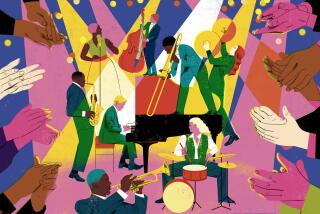Lurie Plays Up Vocal Skills
- Share via
Seattle’s history as fertile rock music territory is old news, but it now seems to be producing some compelling, stylistically eclectic jazz, as well. The Jessica Lurie Ensemble, which performed at Rocco’s in Hollywood on Friday and Saturday night, is a good example.
Alto saxophonist Lurie has been a regular with the Billy Tipton Memorial Saxophone Quartet and the trio Living Daylights, employing her instrumental skills, vocal abilities and compositional efforts in consistently cutting-edge fashion.
In her own ensemble, she has the opportunity to stretch even more, and Saturday night’s performance was an exhilarating display of the unheralded but impressive music that is being made--in Seattle and beyond--by adventurous young artists.
The Lurie ensemble also included tenor saxophonist Sue Orfield, guitarist Jason Seed, bassist Reuben Radding and drummer Greg Campbell, and much of the program traced to the group’s first album, “Zipa! Buka!”
Lurie and Orfield, the band’s front-line players, worked in strikingly synergistic fashion, easily wending their way through the often tricky lines and twisted meters of Lurie’s originals.
Both displayed an accomplished ability to interweave far-out, avant-jazz excursions through the outer limits of their horns with a more mainstream sense of swing.
Lurie’s soloing, in addition, was tinged with an unusual seasoning of Eastern European melody-making.
Seed, reminiscent at times of John Scofield, primarily surveyed the territory between electric rock and straight-ahead jazz, while Radding and Campbell played largely supportive roles.
The biggest surprise of the set, however, was Lurie’s vocalizing. Her intimate tonal blending with Orfield’s saxophone on “J’ai Faim,”--sometimes in unison, sometimes via closely linked harmonies--was a strikingly new-sounding jazz timbre, worthy of more extensive presentation.
Even more intriguing, the group rendering of Alison Krauss’ “Didn’t Leave Nothin’ but the Baby” (from the Coen brothers film “Oh Brother, Where Art Thou”) was a convincing combination of lyrical song and atmospheric accompaniment.
More to Read
The biggest entertainment stories
Get our big stories about Hollywood, film, television, music, arts, culture and more right in your inbox as soon as they publish.
You may occasionally receive promotional content from the Los Angeles Times.








